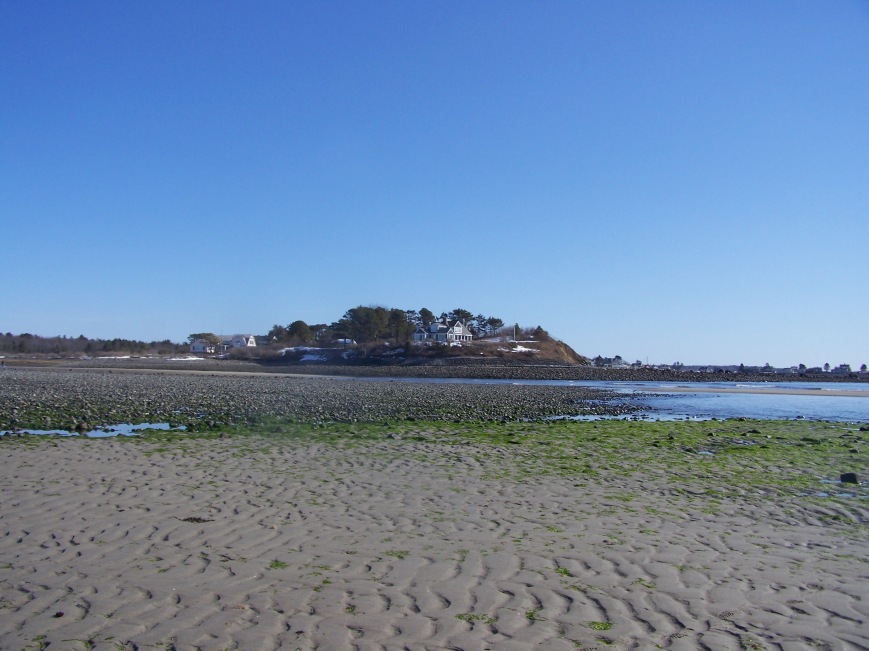
Parson’s beach in Kennebunk, ME. At first glance, not much to be seen besides some algae.
In contrast to a meadow or forest, ocean beaches can often seem devoid of insect life. At first glance, there is not much to be seen besides seagulls and the occasional washed up dead jellyfish. However, there is often more than meets the eye on a beach. In particular, the wrack line, the highest reach of the high tide where dead seaweed and other debris piles up, is often teeming with life. The most obvious animals there will invariably be the small leaping beach hoppers (Talitridae), but these are crustaceans, not insects. The next most obvious animal will be this fly:

Coelopa frigida – kelp fly (two different individuals) – Kennebunk, ME.
This is Coelopa frigida, the kelp fly. The 35 species in its small family, Coelopidae, all live in the coastal wrack zone and feed exclusively on decaying kelp. C. frigida is the only species in its genus in the eastern U.S. and can be found up and down the coast. These animals can be extremely, extremely abundant in their preferred habitat, but go less than a mile inland and you’ll be hard pressed to find even a single one. Having lived near a beach for about seven years, I never paid much thought to Coelopa. It was always a very common species in my area, even into very late fall, and was one of the first insects to emerge in the early spring. However, while taking Insect Biology during my first semester at Cornell, a class which required one to make an insect collection, I realized that here was a distinctive family that nobody could collect in Ithaca, there being no rotting seaweed anywhere near! While back home over Thanksgiving break, I collected a large series of them (which entailed about a minute of knocking the contents of a lump of old seaweed into a vial) and brought them back to Cornell with me to share. They were eagerly snapped up by other students looking for additional families to fulfill the class requirements.

A weird sepsid – Orygma luctuosum (Kennebunk, ME). Note the differences in head shape, wing venation, and color from Coelopa.
Occasionally while observing Coelopa swarming over the wrack on the beach, I would catch sight of another species of fly, quite similar to Coelopa, but larger and darker. These turned out to be Orygma luctuosum, another specialist on rotting seaweed. Orygma has its own monotypic subfamily in the family Sepsidae. This species much prefers to run than fly, and will often just try to hide under seaweed, rocks, or other debris rather than simply fly away. They seem to be less common than Coelopa but they are certainly around; you just need to search a bit more actively to get a good look at one.

Female Anisolabis maritima, the maritime earwig. Note the symmetrical forceps.
The third insect I almost always see at the beach is a very large, black, entirely wingless earwig called Anisolabis maritima. Commonly known as the maritime earwig, this is a European species that has spread to most shorelines worldwide. They are generalist scavengers/predators and usually feed on the kelp flies or beach hoppers that are so abundant in wrack. Anisolabis is likewise extremely abundant in this habitat, although I have found isolated individuals somewhat further inland, suggesting that they do get around a bit. Females tend clutches of eggs and supply food to young nymphs.

In males of Anisolabis, the right forcep is much more bent inward than the left one, an easy way to tell the gender of your specimen.
These three species I can almost always expect to see whenever I venture down to the Kennebunk beaches. However, on very windy days, there is often an abundance of other insect species, blown out of their field or forest habitats onto the beach. Beach collecting on windy days can be extremely productive, yielding tons of uncommonly seen stuff. But, I’ll leave that topic for another post.

The tracks of a maritime earwig in the sand.
